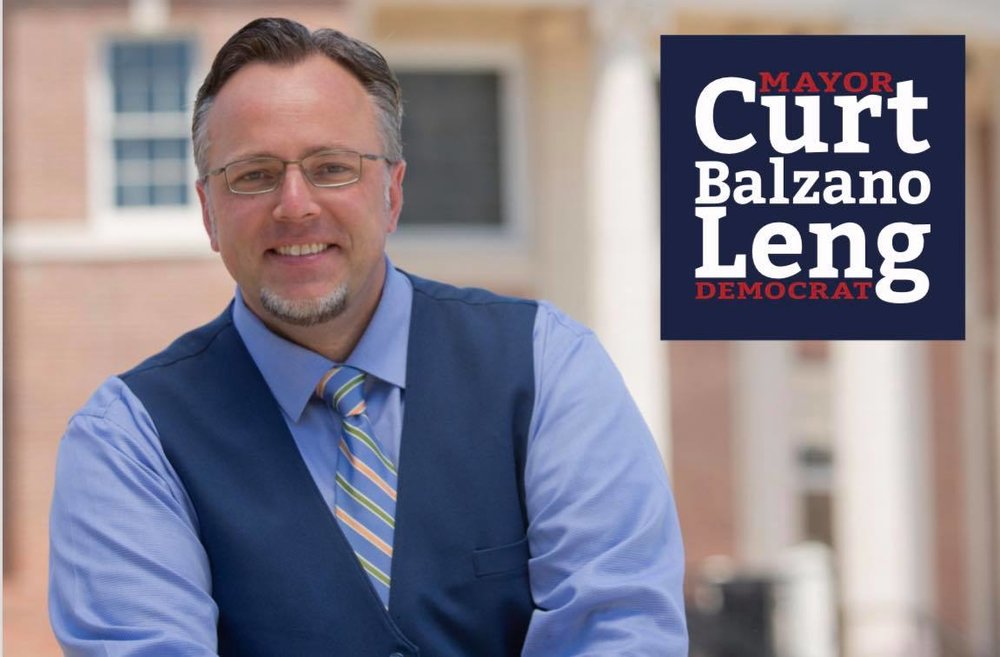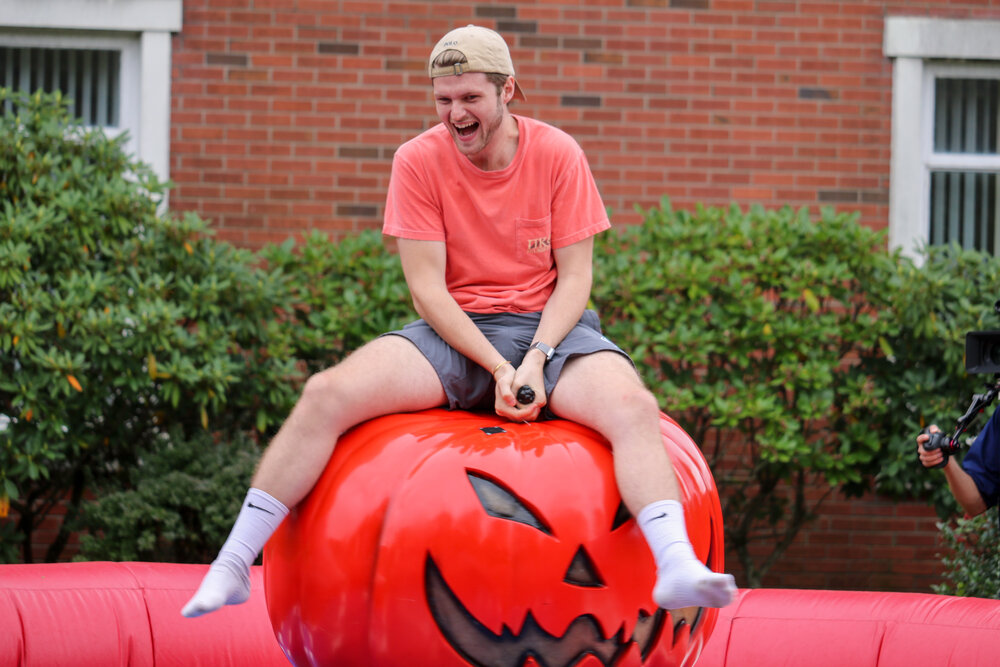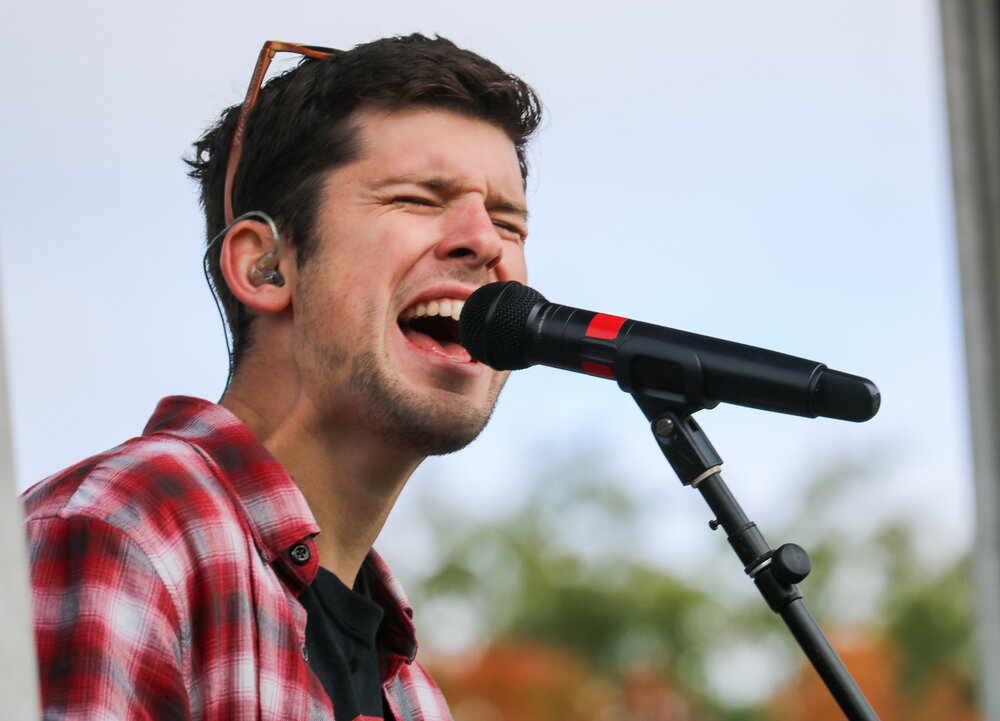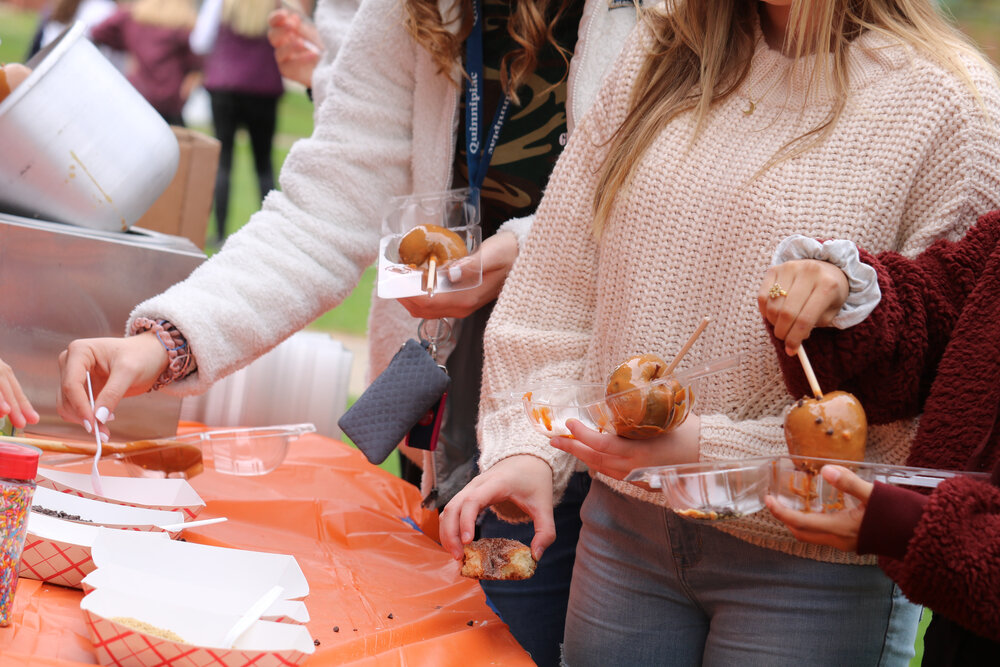Operating an aerial lift, Megan Craig stood three stories high painting salt water marshes on the upper levels of Cold Spring School, a progressive independent school on James Street in New Haven. With a projector shining the image on to the side of the building, Craig drew the images of the native plants while students gathered around to join in on the nighttime party. This was just one day out of the 6-month long project where Craig would come out and work with students to paint the building.

Megan Craig worked with the students of Cold Spring School for six months on the mural of salt water marshes.
There are many forms of art that can be found whether it is commissioned, a mural, a sculpture, a tribute or a tag, artists are just looking to express themselves or their views. With cities and local communities beginning to endorse and commission works of art throughout town, public art and graffiti battle to find a balance.
Craig was a parent of one of the students at the school and after noticing the bricked-over windows at Cold Spring School, Craig decided to reach out and suggested painting a mural on the wall. She had previously worked with an organization called CITYarts in New York, where artists work with local public schools to create public art.
“It seemed very unfortunate to have a building in that neighborhood that had this sort of fortress-prison like quality with these concrete openings,” Craig said.
The mural depicts the different types of salt marshes that are native to the area and the different types of wildlife that abide there. The fifth graders at the school also spend a large chunk of time studying the salt marshes as a part of their curriculum. Craig and the students worked on an interactive sign where all the plants and animals featured in the painting can be found. It was critical that the project was able to tie back into the curriculum for the community to get on board.
“The idea was to make a mural that could also be sort of a learning wall,” said Craig. “I think once we were able to tie the mural into the curriculum, especially the teachers were a lot more excited about it and, and it really kind of gained momentum.”
Although the school was on board with the idea of a mural, the vibe of the community was still mixed. While some people were enthusiastic about the idea of the painting others felt like the area was fine the way it was.
“I think a lot of people were very enthusiastic ” Craig said. “And were sort of like, yes, anything’s better than these concrete block windows. But there were several people who felt like the block was actually fine and it was this very quiet kind of serene facade and why mess with that? So it was a mixed kind of reaction.”
With community projects, Craig has found it vital to make sure that the members of the community feel involved in the process. This fall, Craig worked on a geometric painting on Pearl Street that led up to the Yale School of Management. In order to make the neighborhood to feel included in the design process, she made numerous designs for the community to choose from and presented them over several meetings with the neighborhood.

Geometric pattern that Craig painted in front of the Yale School of Management on the corner of Pearl and Lincoln Street.
New Haven communities have been working with local organizations to commission murals across the city, including the New Haven and the Cedar Hill murals.
Along the same lines, Hartford has been working on a new initiative to work with local artists called Paint the City. The project worked with the communities to pick the designs that would win the competition. Seven were chosen as the beginning of the 14 mural project that the city was hoping to see. The city had put $128,000 into the project as a part of the public-improvement initiative Hartford Decides.
As a private school, Cold Spring School was able to decide whether they wanted to commission a mural on the side of their building without having to ask for permission from state or city officials. When it comes to public property though there are rules and regulations that artists must follow.
Hartford artist Corey Pane has been commissioned to work on a lot of public and private property throughout his career and hit multiple roadblocks when it comes to getting a building approved.
“A lot of times when I’ve done stuff through the city, you have to go through the city,” Pane said. “There’s paperwork, you have to get permits, get permission from the mayor and all that stuff takes forever. So there’s been a couple of times where I almost had a wall and I’ve been really excited about it and just kind of fizzles out because the paperwork or like somebody didn’t allow permission or something.”
While commissioned work and community art projects are well received, there are still concerns about tagging, where an individual will use a symbol or series of symbols to mark their territory. On SeeClickFix, a public forum where residents can go and voice their concerns regarding numerous topics, there have been plenty of concerns about graffiti popping up around New Haven.
One user pointed out the symbol of three circles forming a triangle on numerous spots around New Haven.
“I’ve seen a surge in this type of graffiti / tagging across new haven,” SeeClickFix user Winchester-Dixwell-Community said. “I’m assuming it’s gang related. It has surged in the last two weeks so I’m wondering what’s going on. I wish the city would step in swiftly clean this type of tagging.”
Though the city has rules and regulations in place, some residents feel as though they aren’t moving fast enough to clean up the city. In response to one of the posts about graffiti a user commented advice on how to clean it up.
“I bought some graffiti removal wipes on Amazon,” Winchester-Dixwell-Community said. “They work really well. I got tired of waiting for the city to clean up the graffiti in my neighborhood (they never do). You might have to do the same.”
While graffiti can bring life and beauty to a city, it also costs the city a lot of money to clean up. New Haven budgets approximately $30,000 a year to cleaning up paint around the city, according to the Livable City Initiative Downtown/Wooster Neighborhood specialist, Carmen Mendez.
“Unfortunately, no sooner do we clean it up before another graffiti artist thinks it’s a clean canvass for their graffiti,” Mendez said. “It is a vicious cycle that the City loses time and time again. There are more graffiti artists then there is money to clean it up.”
Graffiti goes against the anti-blight and property maintenance laws. The law states that when considering “the foundation walls of every building,” “the exterior of buildings,” “fences” and “storefronts,” have to remain free of any graffiti.
“Even if we know who the graffiti artist is, unless we catch them in the act or have a picture that ties them to the graffiti, we can do nothing,” Mendez said. “The penalties are stiff per graffiti piece, and we do prosecute. However, to get them to pay, let’s say $9-15,000.00 takes a long time, even when the judges rule in our favor.”

New Haven mural by Josh Griffin at 1050 State St.
As local neighborhoods begin to raise money for murals around town, many are left to wonder what the difference is between paid art and free art? What’s the difference between street art and graffiti? John O’Grodnick, a visual artist based out of New York City believes the difference is only found in the legality of where the art is placed.
The main difference between Street art/Murals and Graffiti is that Most of the time street art is legally and paid by the owner of the building,” O’Grodnick said. “Graffiti is almost always done illegally or without permission and that’s why it’s looked down upon.”
The moral dilemma is finding the line to draw in between expression and defamation. While art can be beautiful and liven up a city or town, can it cross a boundary? And where is that boundary?
“I never think it’s a good idea to, to paint on somebody’s property, you know, as people who are property owners who have to deal with graffiti,” said Craig. “But I do think there should be more open areas for street art where people do not have to get permits, do not have to get permission and have access to big surfaces that they can express themselves in an urban environment.”
Heaven Skate Park: Museum of Public Art, located in Hartford, allows for artists to freely paint across the grounds of the park. There are no rules or regulations regarding who can paint what or where.
“I would say just let it all happen,” said Pane. “I don’t care. Like even like little tags and stuff. If you just do other stuff and it’s like a building that it’s not really bothering you. I don’t see a problem.”
While members of the community work together to clean up graffiti or tags that they don’t feel represent their area well, there are still many works of art around town that portray the culture and life of those around them. With murals and commissioned work popping up around town like the “Greetings from New Haven” and “Welcome to Cedar Hill,” there is an acknowledgement that art, commissioned or not, does bring pride and joy into the community.





